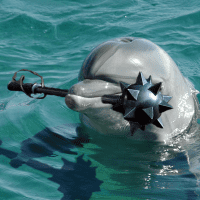
The Ukranian navy dolphin program is a remnant of the massive Soviet fleet that has been kept after the division. Apparently, the haywire dolphins abandoned their handlers during training exercises, most likely to seek a mate. Yury Plyachenko, a former Soviet naval anti-sabotage officer, said this behavior is rather typical during mating season and is far from being unheard. I’ll tell you what’s unheard though: horny, killer dolphins running loose! Reports have it that the dolphins might actually be armed.
Usually, the deserting dolphins return after a week back to their post, but it’s been two weeks and two days since the three dolphins took off. Meanwhile, the Ukranian defense minister has been quick in dismissing any claims that the government’s navy employs any dolphins of any kind. Local news media and amateur footage, however, have been constantly reporting sightings in the Sevastopol area of cetaceans tooled up with a mysterious arsenal of weaponry.
The US Navy currently has a $28 million marine mammal program, which trains and employs 80 bottle-nosed dolphins and 40 California sea lions to detect and clear mines and other dangers from ports. If you find this disturbing, know that animals have always been exploited for war purposes. During WWII for instance, again, the Soviets trained dogs fitted with explosives to run under Nazi tanks and destroy them. MI5 considered using a team of trained gerbils to detect terrorists flying into Britain during the 1970s. These are just a few examples.
Still, today animals aren’t that used for military purposes anymore, not because of a sudden change in consciousness, but because robots are a lot cheaper and reliable nowadays.
UPDATE: according to this newspaper report, it seems like the alleged desertion of three military trained dolphins was a hoax. That’s not to say however that these navy dolphins themselves do not exist. The Ukrainian government has confirmed all its six dolphins and one sea lion are confined in cages and indoor swimming pools at the NDC APU “State Oceanarium”.






